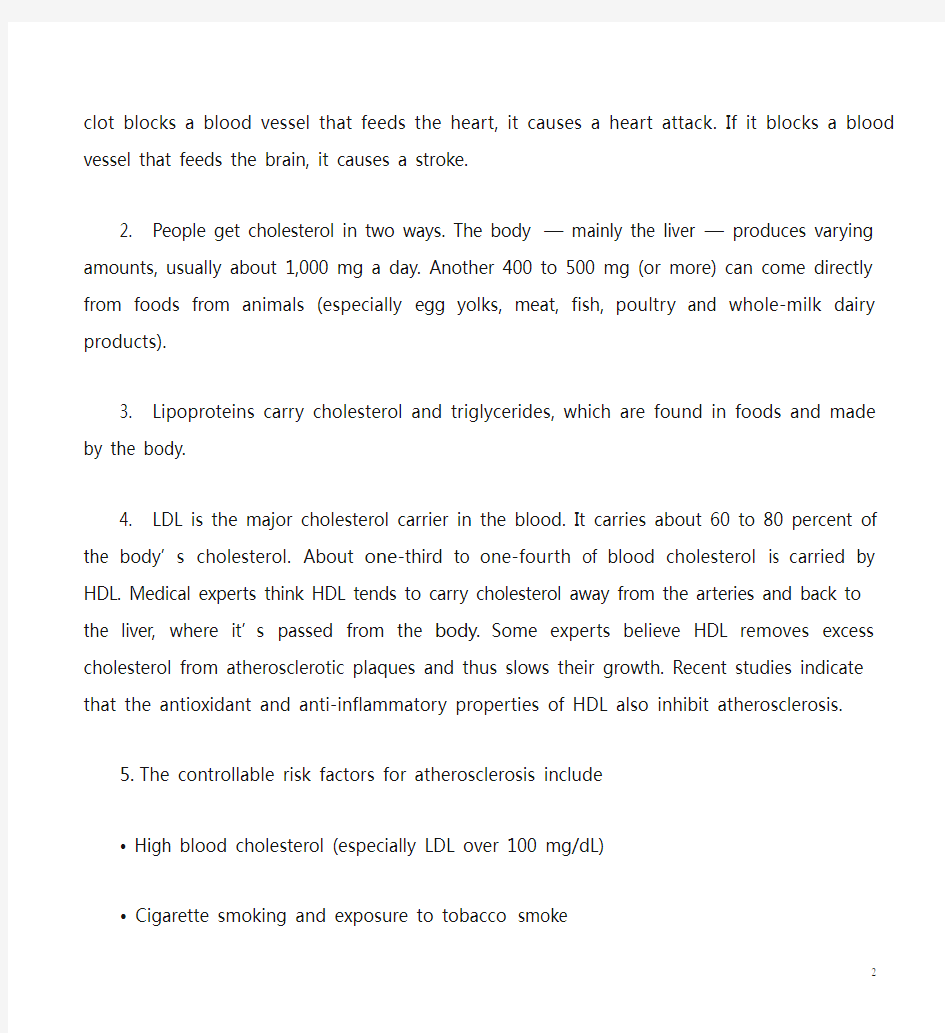答案(Coronary Artery Disease)


Key to Exercises
Coronary Artery Disease
Part One
Warming Up
1.Causes of heart disease include h igh blood cholesterol, high blood pressure, diabetes
mellitus, obesity, physical inactivity, tobacco smoke, stress and alcohol.
2.Omitted
Part Two
Text A
1. Reading Comprehension
1. Atherosclerosis is the hardening of the arteries caused by the buildup of plaques in artery
wall. When plaques become large enough to thicken the endothelium significantly, the artery’s diameter shrinks a nd blood flow decreases, reducing the oxygen supply.
Rupture plaques may cause a blood clot to form that can totally block blood flow in the artery. If a clot blocks a blood vessel that feeds the heart, it causes a heart attack. If it blocks a blood vessel that feeds the brain, it causes a stroke.
2. People get cholesterol in two ways. The body — mainly the liver — produces varying
amounts, usually about 1,000 mg a day. Another 400 to 500 mg (or more) can come directly from foods from animals (especially egg yolks, meat, fish, poultry and whole-milk dairy products).
3. Lipoproteins carry cholesterol and triglycerides, which are found in foods and made by
the body.
4. LDL is the major cholesterol carrier in the blood. It carries about 60 to 80 percent of the
body’s cholesterol. About one-third to one-fourth of blood cholesterol is carried by HDL.
Medical experts think HDL tends to carry cholesterol away from the arteries and back to the liver, where it’s passed from the body. Some experts believe HDL removes excess cholesterol from atherosclerotic plaques and thus slows their growth. Recent studies indicate that the antioxidant and anti-inflammatory properties of HDL also inhibit atherosclerosis.
5.The controllable risk factors for atherosclerosis include
? H igh blood cholesterol (especially LDL over 100 mg/dL)
? Cigarette smoking and exposure to tobacco smoke
? High blood pressure
? Diabetes mellitus
? Obesity
? Physical inactivity
6.H ealthy adults and children aged 2 and older eat a diet that’s low in saturat ed fats and
cholesterol.
7.Omitted
2. Vocabulary
1. thrombus
2. inflammation.
3. atherosclerosis
4. gangrene
5. cholesterol
6. plaque
7. endothelium
8. embolus
9. stroke
10. membranes
3.Translation
A
1.检测高密度脂蛋白胆固醇和低密度脂蛋白胆固醇水平旨在评估动脉硬化的程度,
以便确定心脏病发作或发生中风的可能性。
2. 由于动脉内壁受到损坏,脂肪、胆固醇、血小板、细胞残骸、钙和其他物质沉积在
动脉壁上。
3. 研究表明,细胞内胆固醇含量增加,细胞表面受体数目就会减少,而血液中低密度
脂蛋白含量上升。这可导致更多的胆固醇堆积在动脉壁上。
4.超低密度脂蛋白和乳糜微粒把甘油三酸酯释放到体细胞中,含有蛋白质、脂肪和胆
固醇的碎片就脱离开来。
5. 研究还表明,若循环血液中发生炎症,可能会引发心脏病和中风。
B.
Several risk factors for the development of coronary artery disease have been identified by epidemiological studies. The more risk factors present in any individual patient, the greater the likelihood that he will develop coronary artery disease. However, there is no absolute correlation between risk factors and incidence of coronary disease. Mortality from coronary artery disease is much higher in males than in females, and females lag behind males in coronary artery disease deaths by approximately 10 years.
Part Three
Text B
Reading Comprehension
A.
1 F
2 T
3 F
4 F
5 T
6 F
7 T
8 F
B.
1.There are four main types of stroke: cerebral thrombosis, cerebral embolism,
subarachnoid hemorrhage and cerebral hemorrhage.
Cerebral thrombosis is the most common stroke. It occurs when a blood clot (thrombus) forms and blocks blood flow in an artery bringing blood to part of the brain.
Cerebral embolism occurs when a wandering clot or some other particle (an embolus) forms away from the brain, usually in the heart. The bloodstream carries the clot until it lodges in an artery leading to or in the brain and blocks the flow of blood. Most of these embolisms are blood clots that form during atrial fibrillation.
A subarachnoi d hemorrhage occurs when a blood vessel on the brain’s surface ruptures
and bleeds into the space between the brain and the skull (but not into the brain itself).
A cerebral hemorrhage occurs when a defective artery in the brain bursts, flooding the
surrounding tissue with blood.
2. Stroke affects different people in different ways. Brain injury from a stroke can affect
the senses, motor activity, speech and the ability to understand speech. It can also affect behavioral and thought patterns, memory and emotions. So while helping a stroke survivor to improve his physical and behavioral condition, proper concern should be given to their emotional changes.
Part Four
Further Reading
Topic 1 D
Topic 2 A
Topic 3 B
Topic 4 F
Topic 5 E
